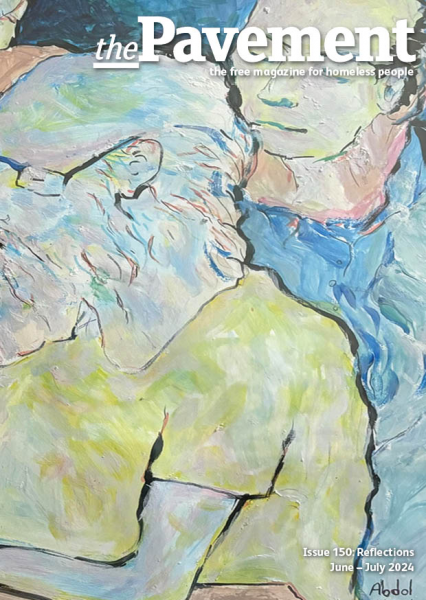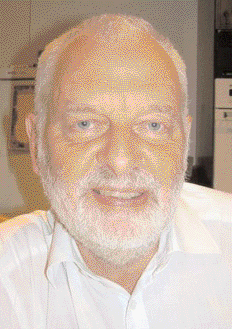
Established 2005 Registered Charity No. 1110656
Scottish Charity Register No. SC043760
DONATE
Please help us to help more homeless people by setting up a monthly direct debit.
the Pavement relies on donations and volunteering from individuals and companies...
MORE ON DONATING
RECENT TWEETS
A river of ribbons commemorates London‘s homeless dead
November 9th saw the annual service for those who had died homeless, held at St Martin's-in-the-Fields, Trafalgar Square, and this year it marked a continuing tradition amidst the tumultuous changes of the construction work next door.
With the work to rebuild the crypt that housed the old day centre into an extended visitors centre and 'one-stop advice shop', there have been many changes, but some of the traditions of the old Social Care Unit remain. One of them is the annual pilgrimage, another is the memorial service for those who died homeless.
This service is traditionally held on the nearest Thursday to Armistice Day. It is a service where those that have passed through the doors of homelessness services, who have gone on to better or worse, but ultimately lost their lives that year, are announced; simply remembered.
The man who co-ordinates much of this occasion is Roger Shaljean. Despite his retirement being announced in this paper a year or so ago, he has (as we suspected) remained a central figure in all things special about the place. Come the autumn, he begins the sad task of collating the names of those who have died during the past year from other homeless organisations.
The toil of many a year warding off the cold, substance abuse or just time, can cut a life short. Some are desperately young, and the fight is lost far too early, but others go on to live to a reasonable age. Although the service is to remember those that died 'homeless', that's not really the point, for there are also those who found somewhere they could call home other than the streets.
Whatever the circumstances, the service is always a dignified event. And the congregation diverse. Among them the homeless and the workers from the area, St Martin's congregation, tourists, and those who have been homeless in the past. This year there was a contingent from Unleash who contributed on the service in conjunction with St Martin's.
After the initial welcome from the Reverend Liz Russell, and some traditional hymns, the real core of the service is the list of those who died homeless. As usual the list was split into four sections. The names were read out by workers, and the enormity and sadness of the occasion slowly grew.
For those who knew those whose names were read out, there can be an almost overwhelming feeling of loss. Hearing those familiar names can often be the first occasion that the news is learned, that they are dead.
The reading out of the names seemed almost relentless, and after each section of names, there was a minute silence. It was planned that the silence would be broken by the single toll of a bell, but instead the silence was broken by the hiss of a pressure hose across the old stonework outside.
Streetwise Opera performed a number, and Alastair Murray reflected upon the hardships and triumphs of the human spirit that he had witnessed during his years working with the homeless.
Every year the service has a different theme. This year, all were invited to take a paintbrush, dip it into a pot of paint, and add a name to a painting specially commissioned for the service. In other years, postcards were produced bearing an individual name from this list, and another year, a river of ribbons and names.
After all was said and done, and we pondered some things that were beyond our understanding, we walked out, past the hoardings on the church, hiding the man still blasting his pressure hose. Big red hoardings that tell us of its renewal into the new century. We went back to our jobs, or wherever we needed to go, and passed the spot where somebody new to me was selling the Big Issue.
If one church is particularly synonymous with the homeless it is St Martin's-in-the-Fields. The present landmark church has stood there since the 18th century, dominating a corner of Trafalgar Square. The St Martin after whom the church is named was a Roman soldier who found God, and then gave his cloak to a beggar. This story was made into action by its famous broadcasting vicar, Dick Shepherd, who threw open the church doors to the returning soldiers during the war.
This open armed policy was continued into the 1940s, when the St Martin's Social Care Service was founded, eventually becoming known as the St Martin's Social Care Unit. The work put into practice there was of real quality displaying love for its fellow man fallen onto hard times. They opened a day centre, offering respite from the cold, a hearty meal, and finding new initiatives for fighting the problems those enduring homelessness, poverty, and hardship regularly faced.
The unit merged with its next door neighbour, The London Connection, in 2003, losing a great name.
June – July 2024 : Reflections
CONTENTS
BACK ISSUES
- Issue 150 : June – July 2024 : Reflections
- Issue 149 : April – May 2024 : Compassion
- Issue 148 : February – March 2024 : The little things
- Issue 147 : December 2023 – January 2024 : Next steps
- Issue 146 : October 2023 – November 2023 : Kind acts
- Issue 145 : August 2023 – September 2023 : Mental health
- Issue 144 : June 2023 – July 2023 : Community
- Issue 143 : April 2023 - May 2023 : Hope springs
- Issue 142 : February 2023 - March 2023 : New Beginnings
- Issue 141 : December 2022 - January 2023 : Winter Homeless
- Issue 140 : October - November 2022 : Resolve
- Issue 139 : August - September 2022 : Creativity
- Issue 138 : June - July 2022 : Practical advice
- Issue 137 : April - May 2022 : Connection
- Issue 136 : February - March 2022 : RESPECT
- Issue 135 : Dec 2021 - Jan 2022 : OPPORTUNITY
- Issue 134 : September-October 2021 : Losses and gains
- Issue 133 : July-August 2021 : Know Your Rights
- Issue 132 : May-June 2021 : Access to Healthcare
- Issue 131 : Mar-Apr 2021 : SOLUTIONS
- Issue 130 : Jan-Feb 2021 : CHANGE
- Issue 129 : Nov-Dec 2020 : UNBELIEVABLE
- Issue 128 : Sep-Oct 2020 : COPING
- Issue 127 : Jul-Aug 2020 : HOPE
- Issue 126 : Health & Wellbeing in a Crisis
- Issue 125 : Mar-Apr 2020 : MOVING ON
- Issue 124 : Jan-Feb 2020 : STREET FOOD
- Issue 123 : Nov-Dec 2019 : HOSTELS
- Issue 122 : Sep 2019 : DEATH ON THE STREETS
- Issue 121 : July-Aug 2019 : INVISIBLE YOUTH
- Issue 120 : May-June 2019 : RECOVERY
- Issue 119 : Mar-Apr 2019 : WELLBEING
- Issue 118 : Jan-Feb 2019 : WORKING HOMELESS
- Issue 117 : Nov-Dec 2018 : HER STORY
- Issue 116 : Sept-Oct 2018 : TOILET TALK
- Issue 115 : July-Aug 2018 : HIDDEN HOMELESS
- Issue 114 : May-Jun 2018 : REBUILD YOUR LIFE
- Issue 113 : Mar–Apr 2018 : REMEMBRANCE
- Issue 112 : Jan-Feb 2018
- Issue 111 : Nov-Dec 2017
- Issue 110 : Sept-Oct 2017
- Issue 109 : July-Aug 2017
- Issue 108 : Apr-May 2017
- Issue 107 : Feb-Mar 2017
- Issue 106 : Dec 2016 - Jan 2017
- Issue 105 : Oct-Nov 2016
- Issue 104 : Aug-Sept 2016
- Issue 103 : May-June 2016
- Issue 102 : Mar-Apr 2016
- Issue 101 : Jan-Feb 2016
- Issue 100 : Nov-Dec 2015
- Issue 99 : Sept-Oct 2015
- Issue 98 : July-Aug 2015
- Issue 97 : May-Jun 2015
- Issue 96 : April 2015 [Mini Issue]
- Issue 95 : March 2015
- Issue 94 : February 2015
- Issue 93 : December 2014
- Issue 92 : November 2014
- Issue 91 : October 2014
- Issue 90 : September 2014
- Issue 89 : July 2014
- Issue 88 : June 2014
- Issue 87 : May 2014
- Issue 86 : April 2014
- Issue 85 : March 2014
- Issue 84 : February 2014
- Issue 83 : December 2013
- Issue 82 : November 2013
- Issue 81 : October 2013
- Issue 80 : September 2013
- Issue 79 : June 2013
- Issue 78 : 78
- Issue 77 : 77
- Issue 76 : 76
- Issue 75 : 75
- Issue 74 : 74
- Issue 73 : 73
- Issue 72 : 72
- Issue 71 : 71
- Issue 70 : 70
- Issue 69 : 69
- Issue 68 : 68
- Issue 67 : 67
- Issue 66 : 66
- Issue 65 : 65
- Issue 64 : 64
- Issue 63 : 63
- Issue 62 : 62
- Issue 61 : 61
- Issue 60 : 60
- Issue 59 : 59
- Issue 58 : 58
- Issue 57 : 57
- Issue 56 : 56
- Issue 56 : 56
- Issue 55 : 55
- Issue 54 : 54
- Issue 53 : 53
- Issue 52 : 52
- Issue 51 : 51
- Issue 50 : 50
- Issue 49 : 49
- Issue 48 : 48
- Issue 47 : 47
- Issue 46 : 46
- Issue 45 : 45
- Issue 44 : 44
- Issue 43 : 43
- Issue 42 : 42
- Issue 5 : 05
- Issue 4 : 04
- Issue 2 : 02
- Issue 1 : 01
- Issue 41 : 41
- Issue 40 : 40
- Issue 39 : 39
- Issue 38 : 38
- Issue 37 : 37
- Issue 36 : 36
- Issue 35 : 35
- Issue 34 : 34
- Issue 33 : 33
- Issue 10 : 10
- Issue 9 : 09
- Issue 6 : 06
- Issue 3 : 03
- Issue 32 : 32
- Issue 31 : 31
- Issue 30 : 30
- Issue 29 : 29
- Issue 11 : 11
- Issue 12 : 12
- Issue 13 : 13
- Issue 14 : 14
- Issue 15 : 15
- Issue 16 : 16
- Issue 17 : 17
- Issue 18 : 18
- Issue 19 : 19
- Issue 20 : 20
- Issue 21 : 21
- Issue 22 : 22
- Issue 23 : 23
- Issue 24 : 24
- Issue 25 : 25
- Issue 8 : 08
- Issue 7 : 07
- Issue 26 : 26
- Issue 27 : 27
- Issue 28 : 28
- Issue 1 : 01

